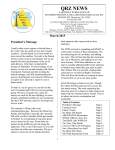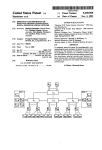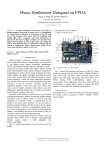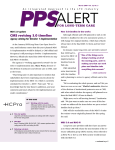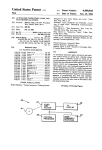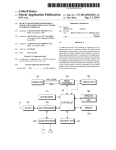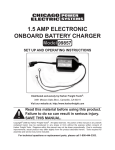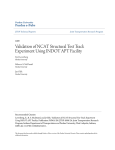Download Use in an electrical power system with a circuit breaker
Transcript
United States Patent [19] [11] [45] Ott et al. [54] PROTECTIVE RELAYS AND METHODS [75] Inventors: Matthew J. Ott, Highland; Timothy - M. Wilkerson, Madison County, both of I11. [73] Assignee: Basler Electric Company, Highland, Ill. ‘ Filed: ' [51] Int. Cl.4 ............................................. .. H02H 3/20 US. Cl. ...................................... .. 361/91; 361/62; 361/59; 361/75; 361/89; 364/483; 340/663 Field of Search ..................... .. 361/21, 35, 59, 62, 361/65, 71, 75, 86, 88, 89, 91; 340/663; 364/483 [56] ' Nov. ' 29, 1988 Assoc., Relay Corn. Mtg, Pittsburgh, PA, pp. l-6, 5.25.84. Pettigrew, “Overexcitation Protection with Micro processor Based Volts Per Hertz Relay”, Pennsylvania Elec. Assoc., Relay Com. Mtg., Allentown, PA, pp. 1-19, 1.18.85. ~ Westinghouse Electric Corp., “Type MVH Micro Apr. 24, 1987 [52] [58] 4,788,619 Basler Electric Co., “EDM 200 Exciter Diode Moni tor”, 4 pages, 1.85. [21] Appl. No.: 42,436 - [22] Patent Number: Date of Patent: processor Volts Per Hertz Relay”, 17 pages, 5-1985. Lakin et al., “Advanced Overexcitation Protection for Generators and Transformers”, Pennsylvania Elec. Assoc., Generator Subcom. of Relay Com., pp. l-9, 9.20.85. Pettigrew et al., “Operating and Application Experi ence with a Microprocessor-Based Volts Per Hertz References Cited Relay, 40th Annual Cont‘. for Protective Relay Engrs., U.S. PATENT DOCUMENTS Title Page, Abstract, Table of Contents, pp. l-27, Apr. 13-15, 1987. Primary Examiner—A. D. Pellinen Assistant Examiner—Derck S. Jennings Attorney, Agent, or Firm-Senniger, Powers, Leavitt 3,590,326 6/ 1971 Watson ............................... .. 361/96 3,703,717 11/1972 Kuster . 4,246,623 l/198l Sun . . . . . . 4,272,816 6/ 1981 Matsumo o 4,420,805 12/1983 Yamaura et al. 340/253 Y . . . . . . . . .. 361/97 364/483 364/ 184 4,428,022 1/1984 Engel et al. . . . . . . . . . . . . . .. 361/96 4,535,409 8/ 1985 Jindrick et al. . . . . . . . . . . . .. 364/481 4,694,374 9/ 1987 Verbanets, Jr. . 361/91 X 4,701,690 10/1987 Fernandez et al. ................. .. 322/28 and Roedel [57] ABSTRACT Protective relay for use in an electrical power system Elmore et al., “Overexcitation Analysis and Detection with Microprocessor-Based Relay”, in Minnesota Power Systems Conference, 12 pp., Oct. 7-9, 1986. having electrical conductors which are energizable with an AC voltage. The protective relay includes a circuit for sensing the AC voltage to produce an AC output that has zero crossings and a time period be tween zero crossings, a circuit for supplying an electri ASEA, “Over-Excitation Relay Type RATUA”, Edi cal signal representing a preselected pickup value of tion 1, 2/76, File R, Part 1, 4 pages. volts-per-Hertz for the relay, and a circuit responsive to the AC output and to the electrical signal for generating OTHER PUBLICATIONS MCS-48 TM Family of Single Chip Microcomputers User’s Manual, Intel, Sep. 1980, Face Sheet plus pp. l-l thru 1-15 and 4-1 thru 4-8. ASEA, “Type RATUB V/Hz Overexcitation Relay for Transformers”, pp. l-3, 6/30/ 82. Beckwith Electric Co., “Pride Programmable Overex citation Relay”, 8 pages Speci?cations, 2 pages Table of Contents and pp. l-59 of text. (pp. 54, 56, 58 absent.) 6-1982. Meisinger et al., “An Overexcitation Relay with In verse Time Characteristics”, Pennsylvania Elec. an electrical level as a function of both the time period and the pickup value and for producing an output signal for the relay when the AC output exceeds the electrical level. In this way, the output signal is produced when a volts-per-Hertz value of the AC voltage exceeds the preselected pickup value of volts-per-Hertz for the relay. Other protective relay apparatus and methods are also disclosed. 61 Claims, 14 Drawing Sheets US. Patent Nov. 29, 1988 Sheet 2, of 14 FIGZ //V577 19/44/09 /0@/ 4,788,619 US. Patent Nov. 29, 1988 Fl 6. 4 V/ Hz Fl(5.5 ‘Va Axum/wrap vi; 05 a; "i Wk * .4 ° Sheet 4 of 14 4,788,619 US. Patent Nov. 29, 1988 Sheet 5 0f 14 4,788,619 kwqw I EQK mt US. Patent Nov. 29, 1988 Sheet 6 of 14 4,788,619 US. Patent ' Nov. 29, 1988 7é (3 I l 1 4,788,619 PROTECTIVE RELAYS AND METHODS 2 down), the generator AC terminal voltage may be much higher than appropriate for excitation purposes relative to the actual electrical frequency, since fre quency is proportional to generator speed. NOTICE Some generators are equipped with automatic volt A portion of the disclosure of this patent document 5 age regulators which supply varying amounts of DC contains material to which a claim of copyright protec tion is made. The copyright owner has no objection to ?eld current to maintain the generator AC voltage at a the facsimile reproduction by anyone of the patent doc preset value at rated frequency. The preset value is ument or the patent disclosure, as it appears in the Pa tent and Trademark Of?ce patent ?le or records, but reserves all other rights whatsoever. reduced by the regulator if frequency falls substantially. An overexcitation relay advantageously is provided as backup protection for underfrequency relaying and Volts/Hertz control functions in the generator voltage BACKGROUND OF THE INVENTION regulator. . The present invention relates to protective relay ap In another application, load tap changing (LTC) paratus for electrical power systems and methods of 15 transformers and line voltage regulators may be sub such protection. More particularly, the present inven tion relates to overexcitation relay apparatus and meth jected to excessive volts-per-Hertz during abnormal system frequency conditions due to their constant volt ods of overexcitation protection. age control function. Also, the failure of an LTC con Overexcitation is excessive magnetic flux density troller may result in a runaway condition producing which saturates the magnetic cores of protected equip 20 dangerously high voltage and consequent overexcita ment such as generators, transformers, and iron core reactors. When a magnetic core is saturated by an alter tion. An overexcitation relay associated with an LTC cally have silicon steel laminations to reduce eddy cur rents. However, during overexcitation the eddy cur rents in the core become a signi?cant factor in the heat operates more swiftly is desirable. Also, it has been known to provide a time trip function in which a condi transformer provides overexcitation protection for the nating current (AC) source, any increase in flux density transformer while allowing a wide range of voltage greatly increases the amount of heat generated in the control operation. core. Modern equipment designs are especially sensitive 25 In the prior art it has been known to produce an to overexcitation because they normally operate with integral of the system voltage and compare it with a high ?ux densities. Automation of substations and gen preset level to determine when excessive volts-per erating facilities is also increasing the need for overexci Hertz is present. However, the process of integrating is tation relaying. The magnetic cores of power system equipment typi 30 time-consuming, and an overexcitation relay which tion of excessive volts-per-Hertz causes a timer to even ing of the equipment. Leakage or stray ?ux also enters tually trip a circuit breaker. vere damage and equipment failure by deteriorating electrical insulation in the equipment. a volts-per-Hertz relay in a predetermined period of time after an excessive volts-per-Hertz condition has During overexcitation heat accumulates in the pro nonlaminated parts such as structural steel of the gener 35 tected equipment. When and if the overexcitation ators, transformers, and reactors to produce substantial ceases, the equipment cools. It has been known to reset eddy current losses there also. Overheating causes se The voltage across a winding on the magnetic core of 40 ceased regardless of the degree of excessive volts-per protected equipment is, according to a basic physical principle known as Lenz’s Law, proportional to the time-derivative of the flux density. Consequently, the ?ux density is proportional to the time-integral of the Hertz and the time during which that condition has persisted. It would be desirable to provide a volts-per Hertz relay that actually and rapidly simulates the real heating and cooling characteristics of protected appara voltage across the winding. In an AC electric power 45 tus. system in which the voltage is essentially sinusoidal, the time integral of the voltage is, by elementary calculus, SUMMARY OF THE INVENTION Among the objects of the present invention are to proportional to the ratio of the voltage to the frequency (in Hertz). Consequently, an overexcitation relay is also provide improved protective relays and methods which called a volts-per-Hertz (V/Hz) relay in the art. Exces can determine the existence of an overexcitation condi sive flux density can occur due to either an overvoltage condition at normal frequency, normal voltage at a tion more swiftly; to provide improved protective re‘ lays and methods which can more precisely and rapidly simulate the actual heating characteristics of protected reduced frequency (underfrequency) or in general an excessive value of the ratio of voltage to frequency. One important application of V/Hz overexcitation relays is to protect directly-connected generator unit step-up transformers. These unit transformers may be subjected to overexcitation during generator startup or shutdown, power system islanding, overloads and load apparatus; to provide improved protective relays and 55 methods which can more precisely and rapidly simulate the actual cooling characteristics of protected appara tus; to provide improved protective relays and methods which can avoid unnecessary tripping and consequent loss of use of protected equipment; to provide improved rejection, any of which conditions can create an under 60 protective relays and methods which are more conve frequency or overvoltage condition and consequent overexcitation. For example, DC ?eld current is typically applied to nient in adjustment and use; and to provide improved generator speed has fallen substantially during shut ing the AC voltage to produce an AC output that has protective relays and methods which are more reliable and economical. a ?eld winding of a generator when the machine is Generally, one form of the invention is a protective above 90% of its rated speed. If the ?eld current is 65 relay for use in an electrical power system having elec applied early (before sufficient generator speed is trical conductors which are energizable with an AC reached on startup), or not removed soon enough (after voltage. The protective relay includes a circuit for sens 3 4,788,619 zero crossings and a time period between zero cross 4 FIG. 3 is a pictorial diagram of controls and displays ings, a circuit for supplying an electrical signal repre on a panel of a volts-per-Hertz relay of the invention; FIG. 4 is a diagram of a varying actual volts-per senting a preselected pickup value of volts-per-Hertz for the relay, and a circuit responsive to the AC output and to the electrical signal for generating an electrical level as a function of both the time period and the pickup value and for producing an output signal for the relay when the AC output exceeds the electrical level. In this way, the output signal is produced when a volts per-Hertz value of the AC voltage exceeds the prese Hertz versus time in an electrical power system; FIG. 5 is a diagram of an electrical signal versus time produced in a volts-per-Hertz relay of the invention, increasing and decreasing and then increasing again until a 100% value is reached whence a trip signal is provided by the volts-per-Hertz relay of the invention, a set of ten display light emitting diodes (LEDS) from the panel of FIG. 3 being aligned with the vertical axis lected pickup value of volts-per-Hertz for the relay. for illustration; In general, another form of the invention is a protec tive relay for use in an electrical power system with a FIG. 6 is a waveform diagram of operations of a circuit breaker for connecting and disconnecting ?rst volts-per-Hertz relay of the invention in various half and second electrical conductors which are energizable 1 with an AC voltage that has a value of actual volts-per Hertz, and with means for sensing the AC voltage to produce an AC output. The protective relay includes a cycles of an AC output waveform; FIG. 7 is a block diagram of a microprocessor-based circuit of a volts-per-I-Iertz relay of the invention; FIG. 8 is a schematic diagram of an input control circuit in part of FIG. 7; FIG. 9 is a schematic diagram of a watchdog circuit circuit for supplying a ?rst electrical signal representing a preselected pickup value of volts-per-Hertz for the for FIG. 7; relay. Another circuit responds to the AC output and to the electrical signal for generating a second electrical FIG. 10 is a schematic diagram of a ?lter circuit in FIG. 1 and in the input control circuit of FIG. 8; FIG. 11 is a schematic diagram of a loss-of-sensing when the value of actual volts-per-Hertz exceeds the pickup value of volts-per-Hertz for the relay and the 2 5 circuit in FIG. 8; and signal which increases in magnitude during the time FIGS. 12-18 are ?owcharts of a main routine, inter second electrical signal decreases in magnitude during rupt routine, and subroutines in the operations and soft the time when the value of actual volts-per-Hertz is less ware of the inventive volts-per-Hertz relay operating than the pickup value of volts-per-Hertz. A further according to methods of the invention. circuit produces a display indicative of the magnitude of 30 Corresponding reference characters indicate corre the second electrical signal as it increases and decreases sponding parts throughout the several views of the in magnitude. ' Generally, a further form of the invention is a protec tive relay for use in an electrical power system with a circuit breaker for connecting and disconnecting ?rst 3 5 and second electrical conductors which are energizable with an AC voltage that has a value of actual volts-per Hertz. The protective relay includes a circuit for sens ing the AC voltage to produce an AC output and an other circuit that responds to the AC output for gener ating a second electrical signal that increases in magni tude from an initial value to an accumulated value when the actual volts-per-Hertz exceeds a preselected pickup level of volts-per-Hertz for the relay. A reset control drawings. DETAILED DESCRIPTION OF PREFERRED EMBODIMENTS In FIG. 1, a three-phase electric power generator 11 is connected by three-phase lines 13 to a delta-Wye unit stepup transformer 21. A neutral N of the generator is conventionally connected by a high resistance ground ing arrangement through a primary 27 of a distribution transformer 31 to ground. The distribution transformer 31 has a secondary 33 across which is connected a grounding resistor 35. An exciter 37 produces DC cur rent for a ?eld winding 39 of generator 11 which con signal representative of a reset rate parameter is sup 4 5 trols the AC voltage produced by the generator 11 across three-phase lines 13, which AC voltage has a plied for the relay. The generating circuit includes cir cuitry responsive to the reset control signal for decreas ing the magnitude of the second electrical signal from value of actual volts-per-Hertz. its accumulated value to the initial value in a reset time type such as one of the SSE type of the assignee Basler Exciter 37 can be a shunt static exciter of electronic interval which varies directly with the accumulated 5 0 Electric Corporation, or a rotary exciter on a common value if the value of actual volts-per-Hertz is less than shaft with generator 11, the rotary exciter in turn hav the pickup level of volts-per-Hertz throughout the reset ing a ?eld winding which is controlled by an automatic time interval. voltage regulator AVR as shown. When necessary, a Other apparatus and method forms of the invention ?eld circuit interrupter 41 disconnects exciter 37 from for achieving the above-stated and other objects of the 5 5 ?eld winding 39 by contacts 43 and closes a set of invention are also disclosed and claimed herein. contacts 45 to instead connect the ?eld winding 39 to a Other objects and features will be in part apparent discharge resistor 47 to rapidly reduce the AC voltage and in part pointed out hereinafter. produced by generator 11 on lines 13. Unit transformer 21 is in turn connected by three BRIEF DESCRIPTION OF THE DRAWINGS FIG. 1 is a block diagram of an electrical power system with equ protected by a volts-per-Hertz relay of the invention; 60 phase lines 49 through a circuit breaker 52 to a three phase bus 55 which conveys electric power to remote lines 56 to a substation load-tap-changing (LTC) power transformer 57. Circuit breaker 52 connects and discon FIG. 2 is a functional block diagram of a volts-per nects the conductors of lines 49 and of bus 55 which are Hertz relay the invention which also represents various 65 energizable with an AC voltage. A primary winding of protective relaying methods of the invention having steps corresponding to the functions associated with the blocks; LTC transformer 57 is connected to remote lines 56, and a secondary winding of transformer 57 supplies three-phase distribution lines 58. 5 4,788,619 Volts-per-Hertz protective relay 59 is an apparatus of the invention operating according to methods of the invention to advantageously act as an “intelligent” ap 6 open Instantaneous Trip (INST TRIP) contacts 85 of relay 59 close. There is no intentional time delay built into relay 59 for this purpose. When contacts 85, close, paratus for detecting excessive volts-per-Hertz condi a circuit is completed to actuate another visual Trip tions in the system of generator 11 and unit transformer Target device 87 which indicates that instantaneous trip has occurred. Contacts 85 and Target 87 are connected in series with each other between fuse 75 and the trip 21. A sensing circuit 61 includes a potential transformer (PT) 63 having a primary connected across two or more of the lines 13 to sense an AC voltage thereacross. PT 63 is represented in block form as it is suitably a system potential transformer feeding another potential sensing coils 41TC and 52TC. In this way, when either a timed trip or an instantaneous trip occurs, the circuit breaker 52 is tripped to isolate the generator 11 and unit trans transformer which latter PT is associated with relay 59. A secondary output of the PT 63 is connected to a low pass ?lter 65 associated with relay 59 that ?lters the 37 and to lower the generator voltage as quickly as fundamental frequency of the AC voltage and suppres possible by means of discharge resistor 47 dissipating former 21 from bus 55; and ?eld circuit interrupter 41 is tripped to disconnect the ?eld winding 39 from exciter ses its harmonics. The ?lter 65 produces an essentially H 5 ?eld current. As a result volts-per-Hertz relay 59 ac sinusoidal AC output, which has zero crossings and a complishes its trip functions to remove a dangerously time period between zero crossings, to the rest of the excessive or persistent volts-per-Hertz condition from volts-per-Hertz protective relay 59. Relay 59 operates a an electric power system. set of output relay contacts which are connected ac Relay 59 also includes self-monitoring functions and cording to a typical application as shown in the lower 20 should these indicate that the relay 59 is malfunctioning, half of FIG. 1. Relay Fail contacts 89 close to energize a Relay Fail It is to be understood that while a simple coil-and warning device 91. contact electromechanical relay is termed a “relay” in A power supply 93 for the circuitry of relay 59 is the electrical art, the phrase “protective relay” (cf. connected to fuses 75 and 77, and suitably has a conven ANSI Standard C37.90-1978) refers to an electrical 25 tional low burden, ?yback switching design which de device designed to respond to input conditions in a livers a nominal :12 VDC. prescribed manner, and after speci?ed conditions are FIG. 2 shows a functional block diagram and method met to cause contact operation or similar abrupt change diagram of volts-per-Hertz relay 59. Potential trans in associated electrical circuits. Limit switches and simi former 63 senses a single phase of system voltage. (An lar simple devices are not protective relays in this sense. arrangement that senses all three phases and relays on A relay may consist of several relay units or circuits, the highest voltage can alternatively be provided.) This each responsive to a speci?ed input with the combina transformer 63 has a maximum saturating V/Hz of 5, for tion of units providing the desired overall performance example, over a voltage range of 10 to 360 VAC and a characteristic of the relay. “Pickup” occurs in a protec frequency range of 2 to 72 Hz. in the preferred embodi tive relay when a speci?c condition or conditions that ment. The AC signal from the secondary of the input the relay is designed to respond to are met. “Pickup” sensing transformer 63 is passed through a low-pass encompasses the activation, initiation or enablement of third harmonic (180 Hz.) ?lter. This ?lter substantially a protective relay timing or other function whether or eliminates the peak distorting effect that third harmonic not an alarm or trip output occurs. content in the AC signal places on a 60 Hz. fundamental Some of the output contacts in FIG. 1 of volts-per 40 waveform. Greater sensitivity and accuracy is achieved Hertz relay 59 are next described. If the actual volts because the third harmonic ?lter attenuates third har per-Hertz exceeds a pickup value for alarm purposes for monic distortion. Potential transformer 63 feeds ?lter 65 a de?nite period of time, normally open Alarm (ALM) which in turn supplies the AC output fundamental fre contacts 71 of relay 59 close and actuate a visual or quency to an Alarm Level Detector 101 with adjustable audible alarm device 73 connected in series therewith to 45 Alarm Pickup thumbwheels 102, Time Trip Level De “+” and “-” supply terminals through two fuses 75 tector 103 with adjustable Time Trip Pickup thumb and 77. If the actual volts-per-Hertz exceeds another wheels 104 and an Instantaneous Trip Level Detector larger pickup value that is set for timed trip purposes, 105 with adjustable Instantaneous Trip Pickup thumb then after a period of time that depends on the subse quent amounts and variation of the actual volts-per wheels 106. Alarm Level Detector 101 turns on an Hertz, normally open Timed Trip contacts 81 of relay 59 close. When contacts 81 close, a circuit is completed to actuate a visual Trip Target device 83 which is a magnetically latched manually reset indicator. Also, contacts 81 are connected to parallel-connected trip coils 41TC and 52TC for the ?eld circuit interrupter 41 and the circuit breaker 52 respectively. The trip coils 41TC and 52TC are respectively interlocked with ser ies-connected auxiliary contacts 41a and 52a of inter Alarm LED 111 to indicate that an alarm pickup value is exceeded, and a de?nite timer 113 with adjustable Alarm Time Delay thumbwheels 114 is activated to determine whether the alarm pickup value is exceeded for at least a predetermined length of time. If so an Alarm Output relay 115 is actuated and contacts 71 of FIG. 1 close. Time Trip Level detector 103 is set to a higher pickup level. If this higher level is exceeded, a time trip pickup LED 117 is turned on to indicate the occurrence. Then rupter 41 and circuit breaker 52 respectively. Contacts 60 an integrator-timer 119 starting from an initial value 410 are closed when the interrupter 41 contacts 43 are electrically accumulates a numerical value toward pos closed and open when contacts 43 are open. Contacts sible trip. An adjustment parameter K for an inverse 52a are closed when main contacts internal to breaker square characteristic for this integrator timer is set by a 52 are closed and open when those main contacts are Time Dial 120. A linear reset circuit 121 responds to the open. 65 time trip level detector 103 when the volts-per-Hertz If the actual volts-per-Hertz exceeds a third pickup value which is set higher than the other two pickup decreases below pickup and causes the numerical value from integrator-timer 119 to decrease in magnitude values for instantaneous trip purposes, then normally from its accumulated value to the initial value in a reset 7 4,788,619 time interval which varies directly with the accumu lated value if the value of actual volts-per-Hertz is less than the time-trip pickup level of volts-per-Hertz 8 red LED Power indicator 131 lights when the power supply is providing nominal -l_-12 VDC to the internal circuitry of relay 59. throughout the reset time interval. A reset slope param Magnetically latching, manually rest Trip Target eter for reset purposes is set by Reset Dial 122. A LED indicators 87 and 83 provide visual indication that the bar graph circuit 123 is responsive to the integrator timer 119 and to the linear reset circuit 121 to produce a display indicative of the magnitude of the numerical value as it increases and decreases in magnitude. If and when the integrator-timer 119 accumulates a value which exceeds a predetermined maximum, a time trip signal is sent to actuate a Time Trip output relay 127 with contacts 81 of FIG. 1. This relay is deactuated respective Instantaneous or Timed Trip trip output relay has been energized. Each Trip Target indicator is manually reset by a target reset lever (not shown). Each of the output contacts of the Volts-per-Hertz relay can be manually actuated by insertion of a § inch diameter nonconducting rod as a Push-to-Energize element through respective access holes 135, 137 and 139 in the front panel. and contacts 81 are opened when the linear reset circuit 121 decreases or reduces the accumulated value to its initial value. In a Time Status Display (TSD) a series of ten LEDs of bar graph circuit 123 are used to indicate accumula thumbwheels 104 adjustably establish the pickup point all LEDs are illuminated, the Time Trip Output relay is energized, closing its contacts 81. When the preselected tion of numerical value towards trip (100%) or decrease Instantaneous Trip Level Detector 105 actuates In thereof toward reset (0%). Each LED represents 10% stantaneous Output Relay 129 and closes contacts 85 of of a total accumulation of 100%. A ?rst left set of three FIG. 1 when the instantaneous trip pickup level on LEDs in the TSD are green, a second middle set of four thumbwheels 106 is exceeded. 20 LEDs are yellow and a third right hand set of three In FIG. 3, front panel details of a preferred embodi LEDs are red. ment of volts-per-Hertz relay 59 are shown. Three In When a preselected level VI-IS on the Timed Trip stantaneous Pickup thumbwheels 106 adjustably estab Pickup thumbwheels 104 is exceeded, the LEDs of the lish a pickup point for the instantaneous trip output. A TSD bargraph circuit 123 are turned on in ascending suitable range of adjustment is from 1.00 to 3.99 V/Hz 25 order from left to right (green G to yellow Y to red R) in 0.01 V/Hz increments. Three Time Trip Pickup as percentage value toward trip is accumulated. When for the time trip output. A suitable range of adjustment is also from 1.0 to 3.99 V/Hz in 0.01 V/Hz increments. Two Time Dial thumbwheels 120 adjustably select a particular inverse square characteristic curve for the relay. Adjustment is from 0.1 to 10 in increments of 0.1. A setting of 00 is equivalent to a setting of 10. Two Reset Slope thumbwheels 122 adjustably estab level on the Timed Trip Pickup thumbwheels 104 is no longer exceeded after trip, the LEDs of the TSD are turned off in descending order from right to left (red to green) as a decrease in percentage value toward reset occurs. When all LEDs in bargraph 123 are extin guished, the Time Trip Output relay 127 of FIG. 2 is lish a linear rate of reset per percent of full-scale accu 35 deenergized, opening its contacts 81. mulated value, or equivalently in per unit of accumu In another hypothetical sequence of events shown in lated value, in integrator-timer 119 to model the cooling rate of protected equipment. Adjustment is from 0.1 to FIGS. 4 and 5, the Time Trip Pickup value VHS (dashed line of FIG. 4) is at ?rst greater than the actual 9.9 seconds per percent of accumulated value in 0.1 volts-per-Hertz 139 in the power system and then is second increments. In other words, if the relay 59 inte 40 itself exceeded by the actual volts-per-I-Iertz 141 for a grator-timer 119 accumulates suf?ciently (100%) to do time. Percentage value 143 toward trip accumulates in a time trip, then the relay will reset in one hundred (100) FIG. 5 during the time of excessive volts-per-Hertz 141, times the number of seconds indicated by thumbwheels and the LEDs of bargraph 123 are turned on in ascend 122 and deactuate the output relay at that time. How ing order of accumulated value ET until some of them ever, if the integrator-timer 119 accumulated 50% of 45 but not all are on at point 144. Then, without any trip the amount needed to trip and then the overexcitation having occurred, the actual Volts-per-Hertz 145 sensed ceases, then the accumulated value will become fully falls below the pickup value VHS. The Time Trip Out reset in 50% of 100 times the time shown on thumb put relay 127 does not close because 100% value has not wheels 122. LED bar graph 123 shows the accumulated been reached. The LEDs of the TSD are turned off in value in the integrator-timer 119 at any given time. A 50 descending order from right to left (yellow to green) as setting of 00 on thumbwheels 122 enables the reset time resetting proceeds and the percentage value 147 falls to be instantaneous. with a slope parameter FP (in seconds per percent) Three Alarm Pickup thumbwheels 102 adjustably determined by the front panel setting on thumbwheels establish the pickup point for the alarm output and are 122. The Time Status Display thus shows in an impres adjustable from 1.00 to 3.99 V/Hz in 0.01 V/Hz incre 55 sively visual way the operations of the Time Trip func ments. Two Alarm Time Delay thumbwheels 114 estab tion of the Volts-per-Hertz relay regardless of whether lish the de?nite time delay for alarm output and are the relay actually trips. adjustable from 0.1 to 9.9 seconds in 0.1 second incre If the actual volts-per-Hertz VH remained below ments. A setting of 00 signi?es an instantaneous alarm pickup VHS a reset time 149 in FIG. 5 would elapse output. whence 0% value would be reached. Before reset time Also, on the front panel of FIG. 3, a red light-emit 149 elapses, however, the actual volts-per-l-Iertz 151 ting diode (LED) Alarm Pickup indicator 111 is illumic exceeds pickup value VHS again. Percentage value 153 nated to indicate that the alarm pickup setting has been exceeded and that the Volts-per-Hertz relay 59 is timing accumulates, this time all the way to l00% at a point for alarm purposes. Another red LED 117 acts as a 127 of FIG. 2 and closes contacts 81 of FIG. 1. Inter rupter 41 and breaker 52 of FIG. 1 are both tripped, Time Trip Pickup indicator which illuminates to indi cate that the time trip pickup setting has been exceeded and that the relay 59 is timing for time trip purposes. A 154 whence the relay 59 trips its Time Trip Output relay removing the excessive volts-per-Hertz condition in FIG. 4. Relay 59 begins the linear reset process again, 9 4,788,619 10 and reduces the percentage accumulated value 155 in FIG. 5 with the same slope parameter FP as the slope and VH is the Actual V/Hz and VI-ISis the V/Hz parameter of the earlier decreasing percentage value Pickup Setting on thumbwheels 104. 147. (Parameter FP in seconds per percent is the recip In actuality, the ratio M varies with time. Accord rocal of the slope in percentage per second.) A reset 5 ingly, an incremental value TIMVAL is calculated at time period 157 is consumed in returning the accumu lated value of 100% to its initial value of 0%. Clearly, the reset time period 157 is longer than the relatively equal intervals DT for equally spaced times N= 1, 2, 3, where short reset time period 149 which would have been used to reset from the lower accumulated value at point 144. TIMVAL=FST><DT/TDL(N) (3) Advantageously, the relay 59 adapts its actual time of and FST is a 100% level of accumulated values that reset to the different projected temperatures of the pro would be needed for a time trip to occur. The incremen tal values are accumulated as‘ a total in a register tected equipment resulting from the history of actual volts-per-Hertz in the electric power system. Also, the relay 59 adapts its actual time T to trip to the relatively accurate simulation of heating and cooling in the pro tected equipment which corresponds to the percentage accumulated value resulting from the history of actual 15 TTTIMER by summing them according to the follow ing recursive equation as long as ratio M exceeds unity: TTTIMER = TTTIMER + TIMVAL (4) When the total TTTIMER reaches a predetermined _ volts-per-Hertz so that unnecessary tripping is pre vented, but necessary tripping occurs as soon as it is 20 value of 100% (FST), a time trip signal is produced. In this way when the ratio M exceeds a preestablished amount (e.g., unity) a digital electrical signal corre sponding to TTTIMER is increased in magnitude by an needed. The Volts-per-Hertz overexcitation relay 59 advanta geously is used to protect generators, transformers, and amount which is a direct function of the excess of the iron core reactors from adverse effects of excessive heating as a result of overexcitation. The relay advanta 25 ratio over the predetermined value. This is because geously models the heating and cooling characteristics of the protected equipment. By accumlating value towards tripping whenever the timed trip volts/hertz pickup setting VHS is exceeded, the relay simulates heat buildup within the protected equipment. Once 30 (M- 1)2 is in the denominator of equation (1) and there fore TIMVAL from equation (3) equals (M-—1)2xDT/(Time Dial Setting). TIMVAL is greater as M increases so that there is a direct function relation ship and not an inverse relationship. Actual volts-per-Hertz VH is proportional to the heated, of course, the metal in the equipment does not product of the measured peak voltage V and the half cool instantaneously. To model the cooling over time, period of each cycle l/(2F), where F is actual fre the volts-per-Hertz relay has a linear reset characteristic quency. Volts-per-Hertz pickup value VHS is propor which can be adjusted to closely correspond to the cooling rate of the protected equipment. In this way, as 35 tional to the product of an electrical level PU for pickup comparison purposes multiplied by the same half-period heat builds up and dissipates within the protected equip of each cycle. Consequently, the ratio M of equation (2) ment due to overexcitation excursions, it is closely pro that should be measured for use in equations (1), (3) and tected by the relay tripping and reset characteristic. (4) is also given by An inverse square timed trip characteristic stored in relay 59 allows relay 59 to be closely coordinated with M= V/PU (5) a “damage curve” for the protected equipment. This close coordination allows optimum utilization of the Using the relationship of equation (5), it is further ad protected equipment by avoiding unnecessary trips and corresponding loss of utilization of the protected gener ating equipment for example. The de?nite time alarm vantageously recognized herein that the ratio M can be 45 periods is readily accomplished by the microprocessor alerting an operator of potentially dangerous condi and inexpensive associated hardware. For this purpose, tions. Once alerted, the operator can take corrective action to prevent the necessity of a relay trip. Alterna tively, the definite-time alarm output contact is used to initiate automatic corrective action. The instantaneous three time periods are de?ned as follows: trip feature provides high-speed tripping for the most severe conditions. To implement the inverse square timing and reset for the Time Trip feature, an Integrating Trip Timer func 55 until a trip output is produced. A total time delay TDL form ?rst exceeds electrical level PU. t0=(t1—t3)/2 60 Inspection of FIG. 6 shows that the ratio M=V/PU is related to these readily measurable time periods by a number of trigonometric equations, some of which are required for time trip at constant ratio M is given by the listed below and are equivalent: formula TDL=(Time Dial Setting)/(M— l)2 A. t1—half-period time interval of AC output ?lter waveform B. t3—period of time in a half-cycle of the waveform during which the waveform exceeds the electrical level PU (calculatedfrom pickup V/Hz VHS on dial 104 and from t1) C. tg-time from zero crossing to instant when wave tion within a microprocessor circuit of relay 59 is initi ated when preselected pickup value VHS has been exceeded. The timer begins timing (ramping up) in ac cordance with a preestablished inverse square curve measured by measuring time periods associated with the AC output waveform from ?lter 65. Measuring of time feature allows even more effective use of equipment by (l) M = i/sinqpmo/n) (6) M = l/cos((pi/2) l3- l1) (7) 65 where M = VH/ VHS (2)











































